ASUS' N82Jv: Jack-Of-All-Trades
by Jarred Walton on September 11, 2010 11:10 PM ESTASUS N82Jv-X2 Low and Medium Gaming
Following our new testing procedure, our gaming results for this midrange GPU and system will look at Low, Medium, and High quality settings. It should come as little surprise that High settings are typically too much for most titles, but we'll get to that in a moment. First, let's start with a look at Low and Medium testing. Again, the M11x R2 and A660D are going to be the main comparison points; the former has the same GPU with a slower (and lower power) CPU, while the latter comes equipped with AMD's "equivalent" of the GT 335M.

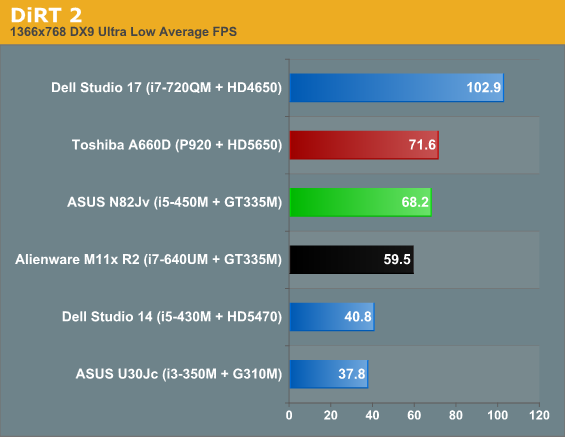
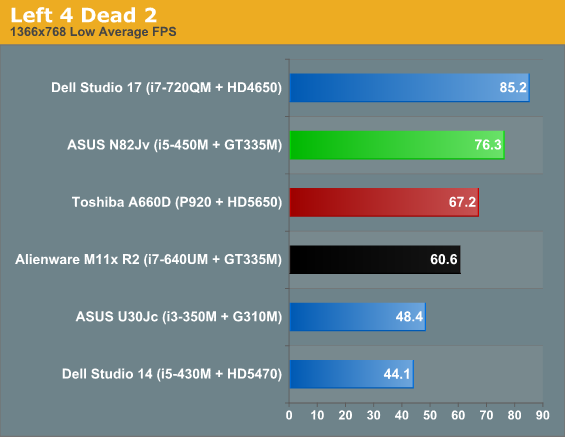
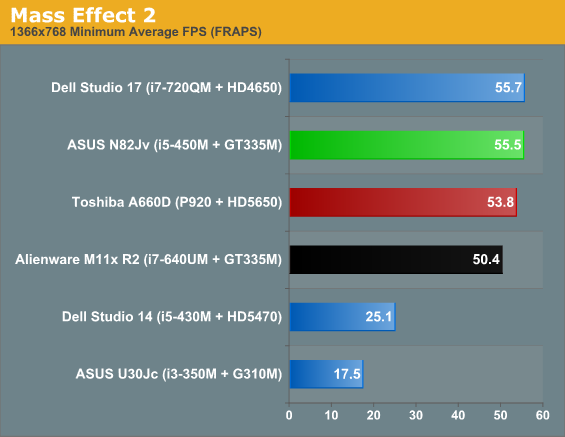
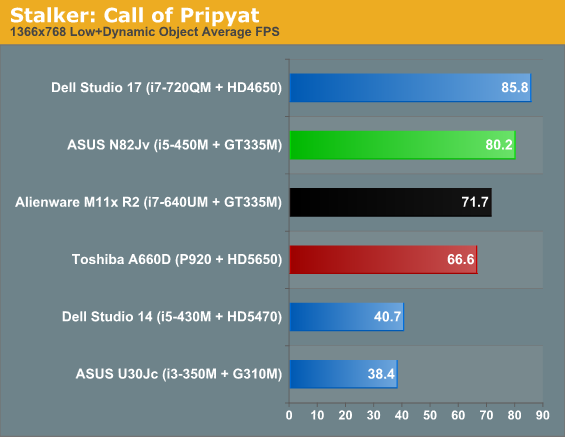

Low quality settings aren't where the GT 335M is designed to play, so frame rates are generally close to or above 60 FPS. The faster CPU in the N82Jv certainly shows up, though it's not the knockout blow you might expect. ASUS beats the M11x R2 by an average of 17% at low detail settings; we expect the margin would grow a bit if we compared with the i5-520UM equipped M11x, but even then there are hints that the system is becoming GPU limited. The lead over the A660D with HD 5650 ends up being 12% on average, but with the A660D winning out by 6% in DiRT 2. Also note that Toshiba is using lower clocked 450MHz 5650 chips, plus the P920 as we already showed is no performance powerhouse, so HD 5650 at 550MHz should come out on top of GT 335M by 10% or more.
A quick look at the Dell Studio 14 also shows why we don't like the gap between 5470 and 5650 in AMD's mobile GPU lineup: outside of StarCraft II, the N82Jv/GT 335M ends up being nearly twice as fast as the HD 5470. The reason StarCraft II doesn't conform to the other results is that Optimus tends to create a few bottlenecks when frame rates get above 60 FPS. Remember that Optimus transfers the completed frames over the PCIe bus to system memory, so you're dealing with memory bottlenecks as well as PCIe congestion. For 1366x768, we're only looking at around 240MB/s of bandwidth, so that shouldn't cause too many issues, but clearly something is holding back the Optimus systems in SC2.
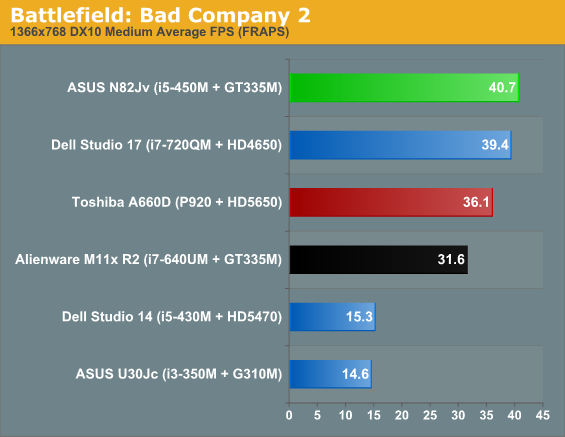
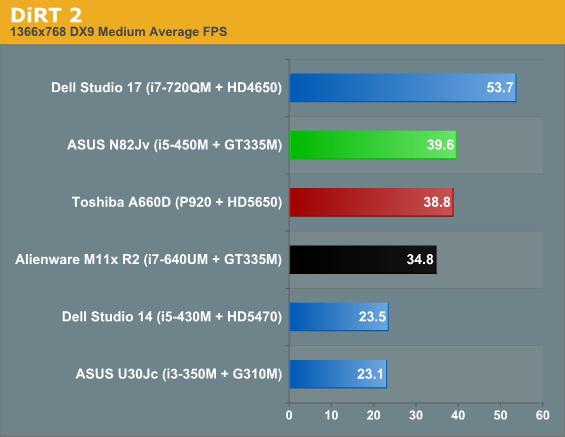

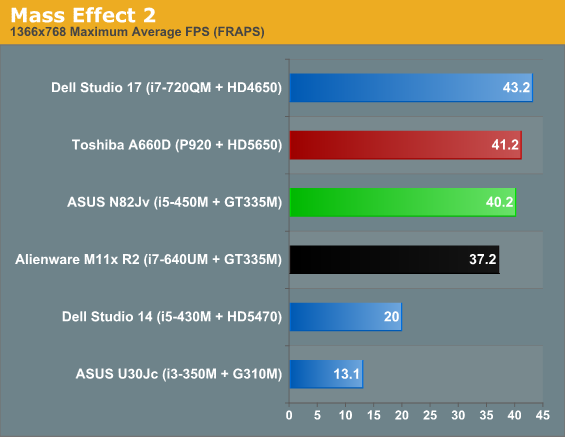
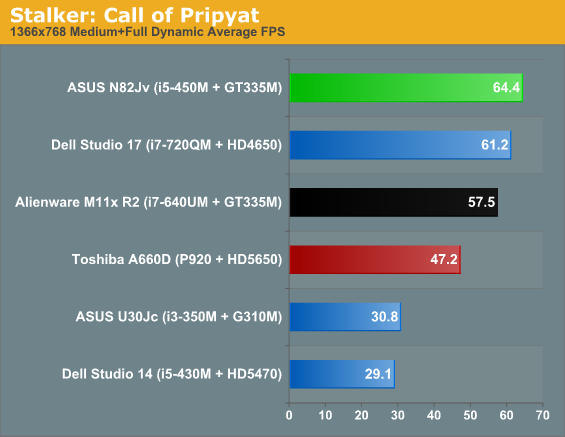
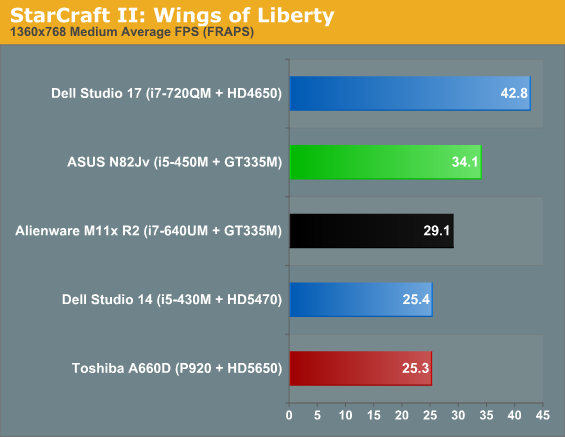
Moving up to Medium details doesn't radically alter the picture, although some of the gaps change slightly. The lead over the M11x R2 drops to 14%, indicating we are becoming more GPU bound. The N82Jv is 13% faster than the A660D, which is nearly the same as the low detail results, but a look at the individual games shows AMD moving into the lead in L4D2 and ME2 by a small margin, while in STALKER and SC2 the GT 335M lead grows to around 35%. How much of the lead comes from the CPU difference vs. the GPU difference isn't entirely clear at this point, though we should have an Acer AS5551G-4591 in house next week to shed some light on things. Also note that the lead over the Studio 14 jumps to 92% average, or 103% if we drop the lower 34% lead in SC2. (Note to Dell: We'd love to see the Studio 14 with an HD 5650!)
Medium quality gaming is where the GT 335M comes into its own. All of the games are at 40FPS or higher, except for SC2 where our intense benchmarking sequence drops average frame rates to 34FPS—still very playable for an RTS! These are all recent titles that can tax laptops quite a bit, and there are plenty of older/less taxing games that will work great on midrange mobile GPUs (World of WarCraft should break into the 60+ FPS range, for example). Is a $1000 laptop going to come anywhere near a $1000 desktop? Not a chance… but then you can't pick up your desktop and walk out the door to go to a LAN party in 60 seconds flat.










33 Comments
View All Comments
JarredWalton - Monday, September 13, 2010 - link
See page two... added the HWMonitor screenshot and some commentary (similar to the above).The Crying Man - Monday, September 13, 2010 - link
Really? Why shouldn't people play games on notebooks? I've been doing it for over 8 years without problems.seanleeforever - Monday, September 13, 2010 - link
gaming on a laptop is full of compromises. you never get a powerful enough CPU/GPU without paying penalty of weight/battery life/heat/noise/price. and two years later, you laptop is out of date and you have NO ABILITY to upgrade it.i am no stranger to notebook gaming. i had that very goal when i entered college (which was many, many years ago). i bought the most powerful notebook with best graphic card available. the system cost over 2k with coupons (which was VERY expensive, i might add). it was high price/heavy weight (5.2 lbs)/heats up like crazy, and poor battery life. it was out of date by the 3rd year in college and barely run any new games with decent settings.
Then, i bought another one (T61P) when it came out, again, the best graphic card in business and expensive like hell. it run games great in that year, but now cannot even run SC2 with medium settings.
the inability to upgrade is really what kills it. when you buy notebooks, you are paying more than Ram/HDD/CPU/GPU. you are paying the whole package. buying a gaming laptop means once the CPU/GPU is out of date, you gonna have to throw the whole thing out, no matter how great the monitor you have, no matter how good the keyboard is, no matter how awesome the system was designed. Notebook manufacture knows about it. they cheapens the design in other areas because they know you gonna move to new gears once Intel/AMD/Nv's new chip is out. long term reliably is no longer a concern (HP, i am looking at you). long term engineering test is complete out of the window because all it matters is to ship the units with the newest chip (the ENTIRE NV lineup were overheating, any body?)
i really love the way desktop works. i can dump a lot of money on a good monitor, keyboard, mouse, cage, audio, and knowing those parts are staying with me no matter i upgrade my system to i7 or i70.
the only thing that keep pushing for new notebooks are games. i can hardly find any reason to dump my T61P besides gaming performance. the new i7 cores are also extremely good (i only have i7 620lm, but it runs 1080 video, VHDL simulation, and matlab code without a problem). so this time around i dumped money into a well designed, ultra portable tablet with one of the best screen in business that i know i will use for the next 5 years. meanwhile i can built myself a gaming machine if i wanted for 30% of the cost.
JarredWalton
believe or not, a lot of people buying notebook not for gaming. i know anand has received a lot of computers in the past, why not create a lab to test
1: sound quality? fan noise?
2: screen quality? (like, take picture from all angels and compare it to others), screen reflection. out door view experience.
3: actual portability. when you travel (the reason for thin and light notebook), you want to work on the go. does the position of the fan make it easily blocked when playing on your lap or other soft surfaces? does it make machine overheat? effect on fan noise?
4. ease to use, such as how accessible is to the HDD and RAM? how difficult it is to do a full on re-store to factory setting? how about drivers support if your HDD is broken and you do not have a DVD shipped with system? how easy to make back on your person files using the provided tool? and how about notebook specific functions (like, if you have thinkpad, you have thinkvantage software that actually does some nice things such as check your system health, check your drivers and install them automatically).
my whole point is that there is SO MUCH MORE to tell other than your new notebook can run crysis and last 5 hours. in fact, gaming performance is maybe what i care the least because as soon as i see the GPU and CPU, i have a good feeling of what this can and cannot do. the Toshiba one is nicely done to point out the crapware that came pre loaded.